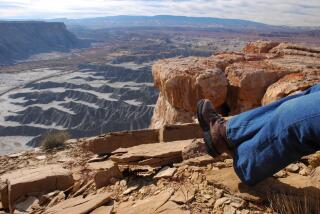Thousands of Volunteers to Hit the Trail for National Public Lands Day
- Share via
WASHINGTON — Ruth Ittner will help build a national forest hiking trail. Dale Waddell will plant trees at a federal recreation site. And Chuck Haugen will kill weeds at a former military base.
About 30,000 people in 48 states --all but Rhode Island and Maine--will dig, sweat and hammer at 200 parks, forests and refuges next Saturday on National Public Lands Day.
What began in 1994 as a low-key event with 700 volunteers at three locations has become a major undertaking.
This year’s festivities have corporate sponsors, backing from eight federal agencies and participation by dozens of volunteer organizations, ranging from the Boy Scouts to the Garden Club of America.
“We want this to end up to be the Earth Day for the public lands,” said Brian Marcus of the National Environmental Education and Training Foundation, a Washington, D.C., nonprofit group that is organizing the event.
The foundation is spending about $240,000 to promote the event with posters, radio public service announcements and a Web site in an effort to nearly double the number of volunteers from last year’s 17,000.
Far from a just feel-good media event, planners say the day will include gritty work such as testing water quality, painting parking lot lines, hauling away dredge piles and building fences and kiosks.
Volunteers will put an estimated $5 million of work into federal lands by the day’s end, organizers say.
“It’s millions of dollars of valuable service for free--it’s stuff we don’t have to go hire contractors to do,” said Tom Fry, principal deputy director at the Bureau of Land Management, the federal government’s largest land manager with 264 million acres.
Other U.S. agencies sponsoring the event are the Army Corps of Engineers, Department of Defense, Environmental Protection Agency, Fish and Wildlife Service, Forest Service, National Park Service and Tennessee Valley Authority.
During last year’s event, about 200 volunteers built a 5-mile trail at a BLM site in Utah--a job that would take a year if left to staff resources, said Brian Bellew, a BLM outdoor recreation planner in Utah.
This year, volunteers will pick up trash, remove graffiti and fortify a historic cabin at the agency’s Red Mountain site outside Vernal, Bellew said.
Ittner of Seattle will lead a group of about 50 volunteers in building a bridge and a new trail, constructing trail hand railings and generally making trails more accessible for the disabled at the Mt. Baker-Snoqualmie National Forest in Washington state.
“You’re meeting a need for trails in the heart of the mountains for people who need this kind of access,” she says. “It’s rare to have the opportunity to have a trail that can be used by wheelchairs, strollers and people who have handicaps.”
Waddell of Portland, Ore., heads a nonprofit group called Wolftree that offers science education to grade school, high school and college students.
He often uses the BLM’s Wildwood Recreation Site outside Portland as an outdoor laboratory, so he’s eager to give something back by helping volunteers improve trails, build an outdoor amphitheater and plant trees.
“Doing something hands-on--a little bit of labor--is very satisfying,” Waddell added.
Haugen, who lives in Del Rey Oaks, Calif., near the former Ft. Ord military base, wondered for years what lurked behind the boundaries there.
Now that the base is closed and the BLM has taken over a section of it, he hikes there.
“It’s a big wild area sort of right in my backyard,” Haugen said. “It’s beautiful country.”
So he’s ready to help keep it beautiful by yanking out invasive exotic weeds that are spreading and destroying habitat for native species.
Recreation visits to BLM lands have grown nearly 50%, to 75 million since 1994, but the recreation budget has grown just 30% in the same period, to $32 million, according to agency figures.
Officials have learned they need the help of volunteers and public and private partners to fill the gap, Fry said.
For instance, he said, the BLM relies on local governments to provide police protection on some land, and encourages private landowners to protect habitat on nongovernment land.
“It used to be that when you wanted to find a way to provide habitat or protect something, you owned it,” he said.
Now agencies realize “we can’t own everything, we can’t control everything. It’s kind of awakened us to new ways of doing business,” Fry said.
But not everybody thinks more reliance on volunteerism and partnering is a good idea.
Scott Silver of Bend, Ore., who has protested the government’s growing reliance on user fees to finance maintenance of public lands, said the increasing number of volunteers doing basic work on public lands makes it easier for Congress to rationalize budget cuts for land agencies.
“I’m very skeptical,” said Silver, who heads an environmental group called Wild Wilderness. “It’s a way that says we can do more with less.”
Fry disagreed.
Volunteer events bring more people out to public lands, which helps boost public support for adequate funding for public lands.
“It will help them to realize how important these are,” Fry said.
Silver views corporate sponsorship of activities on federal land as dangerous too. Toyota, REI and other businesses are contributing $100,000 to National Public Lands Day.
He worries that federal agencies’ land management decisions could increasingly depend on corporate funding.
A complete listing of Public Lands Day sites can be found at https://www.npld.com.
More to Read
Sign up for Essential California
The most important California stories and recommendations in your inbox every morning.
You may occasionally receive promotional content from the Los Angeles Times.










